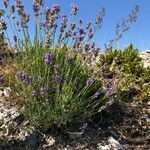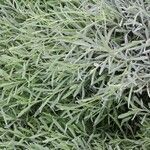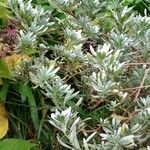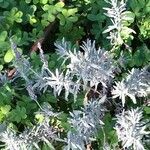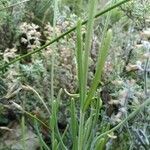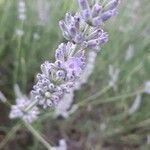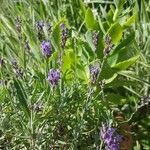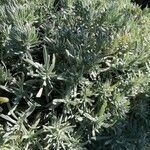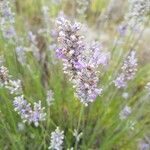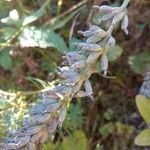Shrubs dwarf, stellate tomentose. Branches gray-brown to dark brown, with long flowering and short leafy shoots, bark longitudinally exfoliating. Leaves widely spaced on flowering shoots, clustered on leafy shoots, linear to lanceolate-linear, 3-5 cm × 3-5 mm on flowering shoots, less than ca. 17 × 2 mm on leafy shoots, gray stellate tomentose, base attenuate to a very short petiole, margin entire and revolute, apex obtuse. Verticillasters 6-10-flowered, numerous, in crowded, interrupted or ± continuous spikes ca. 3(-5) cm; peduncle ca. 3 × as long as spike; bracts rust colored when dry, rhombic-ovate or acuminate-subulate; bracteoles indistinct. Pedicel short. Calyx ovoid-tubular to subtubular, 4-5 mm, 13-veined, densely gray stellate tomentose outside; upper lip entire, lower lip equally 4-toothed. Corolla blue, 8-10 mm, 13-veined, densely tomentose outside, base subglabrous, throat and limb glandular hairy, puberulent annulate inside; upper lip straight, with lobes circular and slightly overlapping; lower lip spreading. Nutlets 4, smooth. Fl. Jun.
More
A herb. Plants grow to 60 cm high and spread to 40 cm wide. The branches are grey-brown. The bark comes of in long layers. The leaves are grey-green. The leafy shoots are short and the flowering shoots are long. The flowers are usually in violet-blue spikes. There are leaves widely spaced on the flowering shoots. The leaves are clustered on the leafy shoots. The leaves are 3-5 cm long by 3-5 cm wide on the flowering shoots and more narrow on leafy shoots. The leaf edges turn up. There are 6-10 flowers on spikes 3 cm long. There are 4 nutlets. They are smooth.
It is a temperate plant. It suits dry exposed sunny positions. It needs a well drained alkaline soil. It is a plant that can withstand frost. It does not suit the tropics or very humid areas. It does best in cool or warm climates with a winter rainfall. It grows between 600-1200 m altitude in southern Europe. It suits hardiness zones 5-10.
More
Dry grassy slopes amongst rocks, in exposed, usually parched, hot rocky situations often on calcareous soils.
Fresh or dried flowers and leaves can be used can be used to flavour jellies, ice cream and cheeses. The leaves, petals and flowering tips are added to salads, dressings, soups, stews, jams and jellies. The flowers can be candied and used as garnish in soft drinks. Fresh or dried flowers are used for tea. It yields an essential oil used as flavouring in food manufacture.
